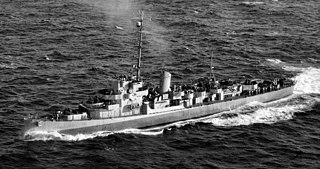
USS Du Pont (DD–152) was a Wickes-class destroyer in the United States Navy during World War II, later reclassified as AG-80. She was the second ship named for Rear Admiral Samuel Francis Du Pont.

USS Hissem (DE-400/DER-400) was an Edsall class destroyer escort of the United States Navy. Hissem was constructed in 1943 as DE-400. In 1955, the vessel was equipped with modern radars, and the designation was changed to DER-400. The special purpose of DER ships was the detection of aircraft. Their chief role was to extend the DEW line out into the N. Atlantic and the N. Pacific oceans.

USS Hilary P. Jones (DD-427) was a Benson-class destroyer in the United States Navy during World War II. She was named for Admiral Hilary P. Jones.

USS Hayter (DE-212/APD-80) was a Buckley-class destroyer escort in service with the United States Navy from 1943 to 1946. In 1967, she was transferred to South Korea where she served as ROKS Jonnam until 1986.

USS Enright (DE-216/APD-66) was a Buckley-class destroyer escort in service with the United States Navy from 1943 to 1946. In 1967, she was transferred to Ecuador where she served until she was scrapped in 1989.

USS Ahrens (DE-575), a Buckley-class destroyer escort of the United States Navy, was named in honor of Private Edward H. Ahrens (1919–1942), who was killed during the Battle of Tulagi and Gavutu–Tanambogo on 8 August 1942. He was posthumously awarded a Navy Cross.

USS Stewart (DE–238) is an Edsall-class destroyer escort, the third United States Navy ship so named. This ship was named for Rear Admiral Charles Stewart, who commanded USS Constitution during the War of 1812. Stewart is one of only two preserved destroyer escorts in the U.S. and is the only Edsall-class vessel to be preserved. She is on display in Galveston, Texas as a museum ship and is open to the public.

USS Huse (DE-145) was a U.S. Navy destroyer escort launched by Consolidated Steel Corp., Orange, Texas on 23 March 1943, during World War II. The ship was sponsored by Mrs. L. M. Humrichouse, daughter of Admiral Harry McLaren Pinckney Huse, whom the ship was named after and commissioned on 30 August 1943.

USS Lovering (DE-39) was an Evarts-class destroyer escort of the United States Navy during World War II. She was promptly sent off into the Pacific Ocean to protect convoys and other ships from Japanese submarines and fighter aircraft. She performed dangerous work in major battle areas and sailed home with three battle stars.

USS Snyder (DE-745) was a Cannon-class destroyer escort built for the United States Navy during World War II. She served in the Pacific Ocean and provided escort service against submarine and air attack for Navy vessels and convoys.

USS Burrows (DE-105) was a Cannon-class destroyer escort built for the U.S. Navy during World War II. She served in both the Atlantic Ocean and the Pacific Ocean, and provided escort service against submarine and air attack for Navy vessels and convoys.

USS Cates (DE-763) was a Cannon-class destroyer escort built for the United States Navy during World War II. She served in the Atlantic Ocean and the Pacific Ocean and provided escort service against submarine and air attack for Navy vessels and convoys.

USS Jacob Jones (DE-130) was an Edsall-class destroyer escort built for the U.S. Navy during World War II. She served in the Atlantic Ocean and provided destroyer escort service against submarine and air attack for Navy vessels and convoys.

USS Hammann (DE-131) was an Edsall-class destroyer escort built for the U.S. Navy during World War II. She served in the Atlantic Ocean and provided destroyer escort protection against submarine and air attack for Navy vessels and convoys.

USS J. Richard Ward (DE-243) was an Edsall-class destroyer escort built for the U.S. Navy during World War II. She served in the Atlantic Ocean the Pacific Ocean and provided destroyer escort protection against submarine and air attack for Navy vessels and convoys. She was named in honor of James Richard Ward who was awarded the Medal of Honor posthumously for his heroic efforts under fire on the USS Oklahoma (BB-37). She was launched by Brown Shipbuilding Co., Houston, Texas, 6 January 1943; sponsored by Miss Marjorie Ward, sister of Seaman First Class Ward; and commissioned 5 July 1943.

USS Otterstetter (DE-244) was an Edsall-class destroyer escort built for the U.S. Navy during World War II. She served in the Atlantic Ocean the Pacific Ocean and provided destroyer escort protection against submarine and air attack for Navy vessels and convoys.

USS Snowden (DE-246) was an Edsall-class destroyer escort built for the U.S. Navy during World War II. She served in the Atlantic Ocean the Pacific Ocean and provided destroyer escort protection against submarine and air attack for Navy vessels and convoys.

USS Hurst (DE-250) was an Edsall-class destroyer escort in service with the United States Navy from 1943 to 1946. The ship served in both the Atlantic and the Pacific and was decommissioned in May 1946 and placed in reserve for the next 27 years.

USS Howard D. Crow (DE-252) was an Edsall-class destroyer escort built for the U.S. Navy during World War II. She served in the Atlantic Ocean the Pacific Ocean and provided destroyer escort protection against submarine and air attack for Navy vessels and convoys.
USS Johnnie Hutchins (DE-360) was a John C. Butler-class destroyer escort acquired by the U.S. Navy during World War II. The primary purpose of the destroyer escort was to escort and protect ships in convoy, in addition to other tasks as assigned, such as patrol or radar picket. She served in the Pacific Ocean, and, post-war, she returned home with a Navy Unit Commendation awarded to her for her battle with Japanese midget submarines on 9 August 1945.



















